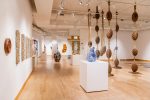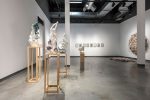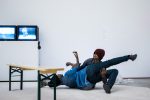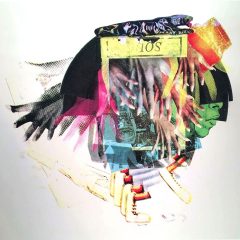[EDITOR’S NOTE: This essay was originally published on November 15, 2016. It was a 2016 Artblog New Art Writing Challenge winner. We feature it today in honor of our new book, “The Noble Art of Art Writing, The Art Writing Challenge” in which it is published. You can order your own copy by emailing editor@theartblog.org.
This post in particular was chosen for its author, 2019-20 University of Delaware Curatorial Fellow, Sam Whalen, who curated the upcoming show SPILL OVER, a Group exhibition at The Delaware Contemporary. The exhibition is on view from March 13 – May 24, 2020 with an opening Reception: Friday, April 3, 5 – 9 PM during Art Loop.
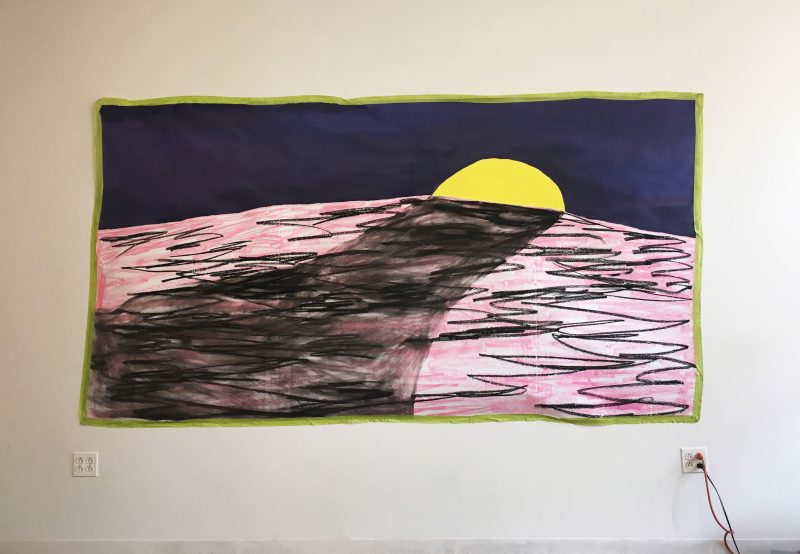
“both happening on parallel things”
Acrylic, charcoal, oil pastel, painters tape on paper.
5x7ft
2016
The Sun is Just the Place Where the Sun Used to Be
by Sam Whalen
The Sun is Just the Place Where the Sun Used to Be
Artists: Alexa Jensky, Conor MacCormack, Esther Micheals
Great Far Beyond – September 2016
Themes
● seasons/cycles
● school
● curation
● personal interpretation
● movement
● methodologies
- Upon entering the exhibition, I first confront a large piece of wood with Crayola colored letters spelling out the title of the show. The point of meditation. “The Sun is Just the Place Where the Sun Used to Be.” ●
- The sun is a fixed point of reference throughout the year. Our humanly constructed cycles rely heavily on tracking our position in relation to the giant ball of fire. ● ●
- The beginning of September is “Back to School” season – a ceremonial time of the year marked by the smell of fresh pencil and paper, repetitive TV sales announcements, and other reminders that the dark days of winter are fast approaching. ● ● ●
- the cut out letters are reminiscent of those used by teachers to announce the date on white boards. There is a false sense of permanency present because they aren’t erasable but can easily be replaced with a new arrangement. ● ● ● ●
- the primary colors add to this scholastic vibe. ●
- the cut out letters are reminiscent of those used by teachers to announce the date on white boards. There is a false sense of permanency present because they aren’t erasable but can easily be replaced with a new arrangement. ● ● ● ●
- The beginning of September is “Back to School” season – a ceremonial time of the year marked by the smell of fresh pencil and paper, repetitive TV sales announcements, and other reminders that the dark days of winter are fast approaching. ● ● ●
- The last weeks of summer carve out new space to be later filled with the anticipation of the next summer. The cycle continues. ● ●
- The ambiguity of the exhibition makes me question if this is even the title but I focus on it as if it is, anyway. ● ●
- The sun is a fixed point of reference throughout the year. Our humanly constructed cycles rely heavily on tracking our position in relation to the giant ball of fire. ● ●
- Eyes scanning the room, I soon come across several depictions of sun-like orbs resting on horizons, taped to the wall. ●
- Are they rising? Are they setting? (see II.B.1. below) ● ●
- The marks are bold, brash, and childlike. They speak to the immediate impatience of wanting to capture a fleeting moment. ● ● ●
- The compositions are essentially all the same with some slight variations in the placement of the sun. ● ●
- EXCEPTION: The large white piece with a black hole for a sun. This is the only piece with the orb fixed high above the horizon.
- Is it even really a sun – or rather a moon? The color is black unlike the others and the white glow seems more lunar. ● ●
- It could be symbolic of winter – when the world seems drained of color. ● ●
- Is it even really a sun – or rather a moon? The color is black unlike the others and the white glow seems more lunar. ● ●
- EXCEPTION: The large white piece with a black hole for a sun. This is the only piece with the orb fixed high above the horizon.
- There is a sense that the artist is detached from the final product. ● ●
- Relating to the overall ambiguous vibe and the only reason I perceive them as finals works and not studies is because they are being presented in a gallery space. ● ●
- The compositions are essentially all the same with some slight variations in the placement of the sun. ● ●
- The relationship between the color of the skies and the ground leads me to believe that these might be representations of different days rather than different times during the same day. ● ● ●
- The sky seems more significant than the earth in these works. I can read them (from top to bottom) as the atmosphere’s erratic response to a day’s end – transitioning from sunset to dead-silent night – or as a seasonal transition. (see I.B. above) ● ● ● ●
- The abstraction of the ground is even simpler with blue (water?) and green (grass?) but the pink casts a questionable glow on how to read the orientation of the works. ● ● ●
- The sun is a golden beacon breaking through the horizon line. The pressure is on the viewer to define where it is at in its orbit. Do you take an optimistic approach or a more pessimistic stance? ● ● ● ●
- The sky seems more significant than the earth in these works. I can read them (from top to bottom) as the atmosphere’s erratic response to a day’s end – transitioning from sunset to dead-silent night – or as a seasonal transition. (see I.B. above) ● ● ● ●
- the pieces are literally attached to the wall with neon green tape – serving as both utility and ornament. ● ●
- I am reminded of the wavy plastic boarders used to disguise chalkboards in classrooms. (see I.A.1. above) ● ●
- Any sense of preciousness one associates with the displaying of artwork is dissolved when the mind wanders to the process of ripping the works off the wall. (see I.A.1.i. above) ● ●
- This adds to the feeling that these are studies and not final pieces – that these are disposable remnants of a process. (see II.B.2.i. above) ●
- Room for potential, growth, and reinvention creates the philosophical foundation for “Back to School” season. Each autumn is another chance to advance/adapt. ● ● ●
- The television resting on the floor provides a point of motion. While the paper suns are suspended mid-cycle through their daily rotation, a camera stalking a pigeon as they explore a city street. ● ●
- In the video, it is a sunny afternoon.
- The shadows are long and deep (see II.B.b above)
- Despite the movement, time feels eternally fixed. The video is on a loop and afternoon sunlight can feel everlasting. ● ●
- this element ties it back into the work on the walls for me. ●
- The video plays on repeat and I observe this bird’s nervous journey over and over again. ● ● ●
- A pigeon is a common, almost forgettable bird. It is easy to mistake one pigeon for another. Pigeons blend in with the flock. ●
- In the video, it is a sunny afternoon.
- The exhibition at large communicates a sense of unity. There is no delineation of credit. The pieces work together to create an overall experience. (see III.C. above) ● ●
- With the other school-like elements, the vibe becomes that of like a group project where each pupil contributes to the holistic final product. ● ● ●
- A temporal interpretation of the exhibition links the anonymity of individual creators back to the air of indifference around the title. ● ●
- Each day, year, moment is like any other. The sum works together to create the totality of something larger. (see I.A. above) ●
- I leave the exhibition fixated on the lack of preciousness surrounding the experience. This becomes a reminder to not take things so seriously in my daily life. (see II.B.2.i. above) ● ●
- There is an awakening of nostalgia for earlier forms of myself propelled by the back to school momentum defining the end of childhood summer. ● ●
- I am nurturing a new perspective on dismissability and value. Sometimes the aesthetics of an object do not accurately predict the experience with the art. ● ● ●
- Sometimes the sun is just the place where the sun used to be.
—
Author’s original text and formatting.
Sam Whalen is a multidimensional artist who’s work explores a wide range of mediums and time based concepts. Her content is driven by a concern for her own mortality (she is a self diagnosed hypochondriac) and focuses on examining her physical and emotional flaws.


